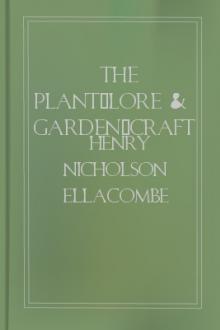The plant-lore & garden-craft of Shakespear, Henry Nicholson Ellacombe [read with me .TXT] 📗

- Author: Henry Nicholson Ellacombe
- Performer: -
Book online «The plant-lore & garden-craft of Shakespear, Henry Nicholson Ellacombe [read with me .TXT] 📗». Author Henry Nicholson Ellacombe
Of fresh Woodbine, be such as never were
To love untrue in word, thought, ne dede,
But aye stedfast; ne for pleasaunce ne fere,
Though that they should their hertes al to-tere,
Would never flit, but ever were stedfast
Till that there lives there asunder brast."
The Flower and the Leaf.
The two last lines well describe the fast union between the Honeysuckle and its mated tree.
FOOTNOTES:[126:1]
Beaumont and Fletcher, Tragedy of Valentinian.
[126:2] Milton probably took the idea from Theocritus—
Gilded with blossom-dust about its lip;
Round which a Woodbine wreathes itself, and flaunts
Her saffron fruitage."—Idyll i. (Calverley).
HYSSOP. Iago. 'Tis in ourselves that we are thus or thus. Our bodies are our gardens, to the which our wills are gardeners; so that if we will plant Nettles or sow Lettuce, set Hyssop, and weed up Thyme, supply it with one gender of herbs or distract it with many, either to have it sterile with idleness, or maimed with industry, why, the power and corrigible authority of this lies in our wills. Othello, act i, sc. 3 (322).
We should scarcely expect such a lesson of wisdom drawn from the simple herb-garden in the mouth of the greatest knave and villain in the whole range of Shakespeare's writings. It was the preaching of a deep hypocrite, and while we hate the preacher we thank him for his lesson.[128:1]
The Hyssop (Hyssopus officinalis) is not a British plant, but it was held in high esteem in Shakespeare's time. Spenser spoke of it as—
and Gerard grew in his garden five or six different species or varieties. He does not tell us where his plants came from, and perhaps he did not know. It comes chiefly from Austria and Siberia; yet Greene in his "Philomela," 1615, speaks of "the Hyssop growing in America, that is liked of strangers for the smell, and hated of the inhabitants for the operation, being as prejudicial to the one as delightsome to the other." It is now very little cultivated, for it is not a plant of much beauty, and its medicinal properties are not much esteemed; yet it is a plant that must always have an interest to readers of the Bible; for there it comes before us as the plant of purification, as the plant of which the study was not beneath the wisdom of Solomon, and especially as the plant that added to the cruelties of the Crucifixion. Whether the Hyssop of Scripture is the Hyssopus officinalis is still a question, but at the present time the most modern research has decided that it is.
FOOTNOTES:[128:1] It seems likely from the following passage from Lily's "Euphues, the anatomy of wit," 1617, that the plants were not named at random by Iago, but that there was some connection between them. "Good gardeners, in their curious knots, mixe Isope with Time, as aiders the one with the others; the one being dry, the other moist." The gardeners of the sixteenth century had a firm belief in the sympathies and antipathies of plants.
INSANE ROOT. Banquo. Were such things here as we do speak about?Or have we eaten on the Insane Root
That takes the reason prisoner? Macbeth, act i, sc. 3 (83).
It is very possible that Shakespeare had no particular plant in view, but simply referred to any of the many narcotic plants which, when given in excess, would "take the reason prisoner." The critics have suggested many plants—the Hemlock, the Henbane, the Belladonna, the Mandrake, &c., each one strengthening his opinion from coeval writers. In this uncertainty I should incline to the Henbane from the following description by Gerard and Lyte. "This herbe is called . . . of Apuleia-Mania" (Lyte). "Henbane is called . . . of Pythagoras, Zoroaster, and Apuleius, Insana" (Gerard).
IVY. (1) Titania. The female Ivy soEnrings the barky fingers of the Elm. Midsummer Night's Dream, act iv, sc. 1 (48). (2) Prospero. That now he was
The Ivy which had hid my princely trunk
And suck'd my verdure out on't. Tempest, act i, sc. 2 (85). (3) Adriana. If ought possess thee from me, it is dross,
Usurping Ivy, Brier, or idle Moss. Comedy of Errors, act ii, sc. 2 (179). (4) Shepherd. They have scared away two of my best sheep, which I fear the wolf will sooner find than the master; if anywhere I have them 'tis by the seaside browsing of Ivy.[130:1] Winter's Tale, act iii, sc. 3 (66). (5) Perithores. His head's yellow,
Hard hayr'd, and curl'd, thicke twin'd like Ivy tops,
Not to undoe with thunder. Two Noble Kinsmen, act iv, sc. 2 (115).
The rich evergreen of "the Ivy never sear" (Milton) recommended it to the Romans to be joined with the Bay in the chaplets of poets—
Inter victrices Hederam tibi serpere lauros."—Virgil.
Prima feres Hederæ victricis præmia."—Horace.
And in mediæval times it was used with Holly for Christmas decorations, so that Bullein called it "the womens Christmas Herbe." But the old writers always assumed a curious rivalry between the two—
Who should have the mastery
In lands where they go."
And there is a well-known carol of the time of Henry VI., which tells of the contest between the two, and of the mastery of the Holly; it is in eight stanzas, of which I extract the last four—
The foresters, the hunters, keep them from the does;
Ivy she hath berries as black as any Sloe,
There come the owls and eat them as they go;
Holly he hath birds, a full fair flock,
The nightingale, the popinjay, the gentle laverock;
Good Ivy, say to us, what birds hast thou?
None but the owlet that cries 'How, how!'"
Thus the Ivy was not allowed the same honour inside the houses of our ancestors as the Holly, but it held its place outside the houses as a sign of good cheer to be had within. The custom is now extinct, but formerly an Ivy bush (called a tod of Ivy) was universally hung out in front of taverns in England, as it still is in Brittany and Normandy. Hence arose two proverbs—"Good wine needs no bush," i.e., the reputation is sufficiently good without further advertisement; and "An owl in an Ivy bush," as "perhaps denoting originally the union of wisdom or prudence with conviviality, as 'Be merry and wise.'"—Nares.
The Ivy was a plant as much admired by our grandfathers of the fifteenth and sixteenth centuries as it is now by us. Spenser was evidently fond of it—
Which being all with Yvy overspread
Deckt all the roofe, and shadowing the rode
Seem'd like a grove faire branched over hed."
F. Q., vi, v, 25.
In another place he speaks of it as—
And in another place—
Knitting his wanton armes with grasping hold,
Least that the Poplar happely should rew
Her brother's strokes, whose boughs she doth enfold
With her lythe twigs till they the top survew,
And paint with pallid greene her buds of gold."
Virgil's Gnat.
Chaucer describes it as—
And in the same poem he prettily describes it as—
As a wild plant, the Ivy is found in Europe, Asia, and Africa, but not in America, and wherever it is found it loves to cover old walls and buildings, and trees of every sort, with its close and rich drapery and clusters of black fruit,[132:1] and where it once establishes itself it is always beautiful, but not always harmless. Both on trees and buildings it requires very close watching. It will very soon destroy soft-wooded trees, such as the Poplar and the Ash, by its tight embrace, not by sucking out the sap, but by preventing the outward growth of the shoots, and checking—and at length preventing—the flow of sap; and in buildings it is no doubt beneficial as long as it is closely watched and kept in place, but if allowed to drive its roots into joints, or to grow under roofs, the swelling roots and branches will soon displace any masonry, and cause immense mischief.
We have only one species of Ivy in England, and there are only two real species recognized by present botanists, but there are infinite varieties, and many of them very beautiful. These variegated Ivies were known to the Greeks and Romans, and were highly prized by them, one especially with white fruit (at present not known) was the type of beauty. No higher praise could be given to a beauty than that she was "Hedera formosior alba." These varieties are scarcely mentioned by Gerard and Parkinson, and probably were not much valued; they are now in greater repute, and nothing will surpass them for rapidly and effectually covering any bare spaces.
I need scarcely add that the Ivy is so completely hardy that it will grow in any aspect and in any soil; that its flowers are the staple food of bees in the late autumn; and that all the varieties grow easily from cuttings at almost any time of the year.
FOOTNOTES:[130:1] Sheep feeding on Ivy—
In multitudes around them, and blossoms like the Rose."
Theocritus, Idyll v. (Calverley).
[132:1]
Shading the Ethiop berries."—Keats, Endymion.
KECKSIES. Burgundy. And nothing teems
But hateful Docks, rough Thistles, Kecksies, Burs,
Losing both beauty and utility. Henry V, act v, sc. 2 (51).
Kecksies or Kecks are the dried and withered stems of the Hemlock, and the name is occasionally applied to the living plant. It seems also to have been used for any dry weeds—
With Wyspes, and Kexis, and ryschys ther lyght,
To fech hom ther husbandes, that wer tham trouth plyght."
"The Tournament of Tottenham," in
Ritson's Ancient Songs and Ballads.
You minimus, of hindering Knot-grass made;
You bead, you Acorn. Midsummer Night's Dream, act iii, sc. 2 (328).
The Knot-grass is the Polygonum aviculare, a British weed, low, straggling, and many-jointed, hence its name of Knot-grass. There is no doubt that this is the plant meant, and its connection with a dwarf is explained by the belief, probably derived from some unrecorded character detected





Comments (0)